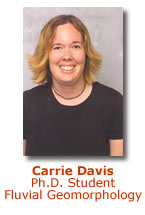Glacial Research
Glaciology represents an area of specific interest to our Geomorphology Group. The lack of glaciers in our very flat Indiana presents the opportunity for students to partake in international research projects! Glacial geomorphology is the study of the interactions between the glacier and land surfaces, as well as the resulting landforms and sediments of areas previously occupied or affected by glaciers. Glacial geomorphology constitutes important research needed to better understand the processes that created those landscapes. After all, look at the wonderful landscape the last major glacial episode provided us here at Purdue University! Furthermore, glaciers are becoming of increasing interest as they are rapidly changing with recent global climatic changes. If you can handle the cold, come chill with the geomorphology group!
CURRENT RESEARCH
Glacial Moraine in NorwayThere are major limitations in the successful use of ice sheet models for climate research due to the limited amount of field data for model calibration. Therefore, if a numerical ice sheet model is to be considered a valid reconstruction of a previous glacial cycle, then the estimated ice marginal positions, subglacial regime, and ice flow orientation and patterns must reasonable agree with field observations. This is an international project coordinated between Jacob Napieralski, Dr. Harbor and members form the University of Stockholm (Sweden) and the University of Edinburgh (Scotland) to simulate the Fennoscandian Ice Sheet (FIS) with a high resolution, three-dimensional, thermomechanical model. A Geographic Information System (GIS) is being used to integrate the model output and field observations into one database, in order to statistically compare the predicted and observed data. The goal is to reconstruct the evolution of the subglacial regime through one complete glacial cycle, while proving that GIS can be used as a successful stand-alone verification tool for numerical ice sheet models.
|
Rock glacier on Tibet Plateau Cosmogenic nuclide techniques are being applied to glacial chronology and geomorphology problems in a collaborative project of Purdue University, Stockholm University and the Australian National University in the study of the Fennoscandian Ice Sheet through LGM. Philip Li is focusing on the relationship between hanging and main valleys, as well as the erosion differences between valley sides and bottom. Preliminary cosmogenic nuclide results have shown different apparent age patterns between valley sides and bottom, as well as in between the hanging and main valley; thus, indicating erosion differences do exist. |
